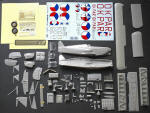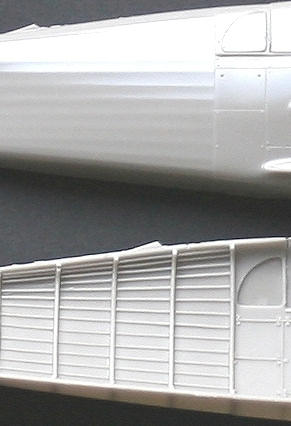
HPH 1/32 AVIA B-534 VERSION IV
|
KIT: |
HPH 1/32 AVIA B-534 Version IV |
|
KIT #: |
HPH 320001 R |
|
PRICE: |
Contact Manufacturor |
|
DECALS: |
4 Decorations |
|
REVIEWER: |
|
|
NOTES: |
163 resin parts, 3 rubber, 101 P/Etched parts, mask Email:
hph@hph.cz
|

|
HISTORY |
The Czech airplane Avia B-534, descending of the B-34 (1932) and B-134 models kept the biplane formula, though the low wing design started to emerge in the western countries industries. Put in service in 1937, it took service as a guard border in Czechoslovakia in the Gendarmerie patrols. The same year at the Zurich World Championship, it took the second place behind the German team on BF-109B aircraft. But its performances evolved successively from model I to the model IV. After the invasion of Germany, this biplane was integrated in the Luftwaffe, mainly in the training schools.
Also used in the Slovak force against the Hungary in 1939, it fought up to Russia. The last victory of a biplane was for this biplane in 1944 against a JU-52.
|
THE KIT |
 Until
this day only models in 1/72 and 1/48 scale were available on the market. Today
the 1/32 scale lovers can add this elegant fighter to their collection, thanks
to HPH.
Until
this day only models in 1/72 and 1/48 scale were available on the market. Today
the 1/32 scale lovers can add this elegant fighter to their collection, thanks
to HPH.
This specialized firm built full scale modern glider G 304C,CZ,S, and static models on request, with a high degree of finishing and personalisation. We would not have therefore to be disappointed, as we will see it.
In a solid partitioned cardboard box, one finds the big parts such the two half fuselages protected by plastic bubble and the other resin pieces and photoetched parts conditioned in bags. The wing is stocked vertically, avoiding distortions and breakage. We have in our hands an extremely detailed, just in form kit (after consulting the available documentation). The fuselage is very light, indeed more than some injected seen elsewhere, with the same volume. There is no deformation, the engraving panels are fine and the rear fabric covered aspect is amazing. The interior is treated as the same manner with the ribs, invisible after construction, except if you "open the structure”
The wing surface is the same aspect, perfectly molded, with a good rendition of the ribs and reinforcements. Additional proof of the serious job in conception, all the masts (gear, wing, stabiliser) are internally reinforced with wire. (that will not exclude you to glue these parts with a two components low cement for a better strength). The interior, from the firewall to the rudder is a tubular structure to built with the help of a jig allowing you to maintain vertically the sides during upper and under tubular addition sections. You also have photo etched cables holders to fit and add cables to replicate the “cage”. The cockpit is extremely complete with the radio boxes, the hand-levers, the oxygen bottle, the hand pump, the flying trim, the machine guns, the cards map case, the seats with the p/e harness and the pre painted dashboard with acetate film. The four flanked machine guns vertically to the left and to right are detailed with their rearmament system. In front of the cockpit, are located the two gasoline tanks ( 90 and 257 litres).
 Even if most parts are
aluminium, the notice does not give the colour for little bits (blue bottle,
green and brown tanks….), but the documentation (MBI)) will help you for the
cockpit, as well as the HPH site. Before closing the fuselage it will be
necessary to prepare the propeller to let it freely rotate.
Even if most parts are
aluminium, the notice does not give the colour for little bits (blue bottle,
green and brown tanks….), but the documentation (MBI)) will help you for the
cockpit, as well as the HPH site. Before closing the fuselage it will be
necessary to prepare the propeller to let it freely rotate.
The tank cork, the exterior visor, the front air inlet are parts to place before the wing step.
For this one, as for all biplane, a home made jig will ensure you to center clearly all the parts. I notice that the cables running from the wing ailerons to the control stick, which pass through the fuselage are not indexed, but it is necessary to add them.(in front of the external visor). At this stage, it is better to insert the p/e wing struts attachments and the flat resin exhaust shrouds. For the wheels, according to the model there will be or not the covers to set. The resin canopy is very clear, the rear wheel, the step foot, the bombs racks and the ventral radiator will be finally placed. All the moveable surfaces are separated, so you could give a less static attitude to the aircraft at rest. For the decoration, you’ll have the choice for four aircrafts. The two first ones in khaki green and silver belong to the 30 and 50 squadrons based at Olomouc and Hradec Kralové in 1937 and 1938. Besides the nationality markings, they carry a blazon (eagle or blue lion).
The third airplane coded S-13 belonged to the Slovak AF in 1944, green and sky blue camouflaged, it bears yellow strips on the nose, the under wing and on the rear fuselage. On this plane, the wheels covers and canopy are missing.
The last airplane is for a gendarmerie patrol force at Hradec Kralové in June 1937. It is completely gray-green and carried OK-PAR registration in red with white edge.
A darker red highlights the three quarter of the outlines of the wings, rudder and stabilizer.
For those who would like to paint the big markings, masks are furnished too. Knowing that this biplane flew under other colours, it will be necessary to find them by yourself.
|
CONCLUSIONS |
As you‘ll see, we have in our hand a high quality kit, well engineered, representing the pre WWII on Eastern front, a period and area yet in the dark. This first model in 1/32 scale is a success.
Recommended without hesitation.
|
REFERENCES |
Avia B-534 - Czechoslovakian Fighter 1933-45 (CMK Photo Hobby Manual 01),
Avia B-534 (MBI),
Avia B-534 (Aero Archiv),
Avia B34-534
(HT Model Magazin Special)
April 2008
Thanks to www.hph.cz for providing the kit.